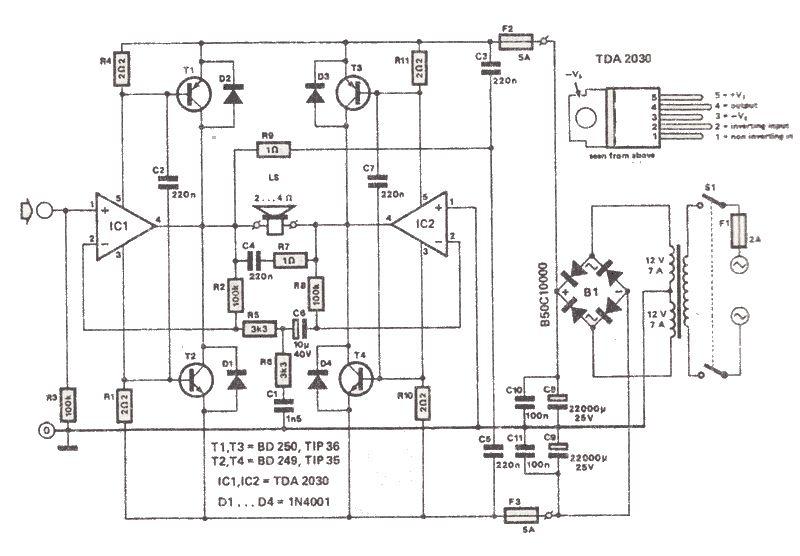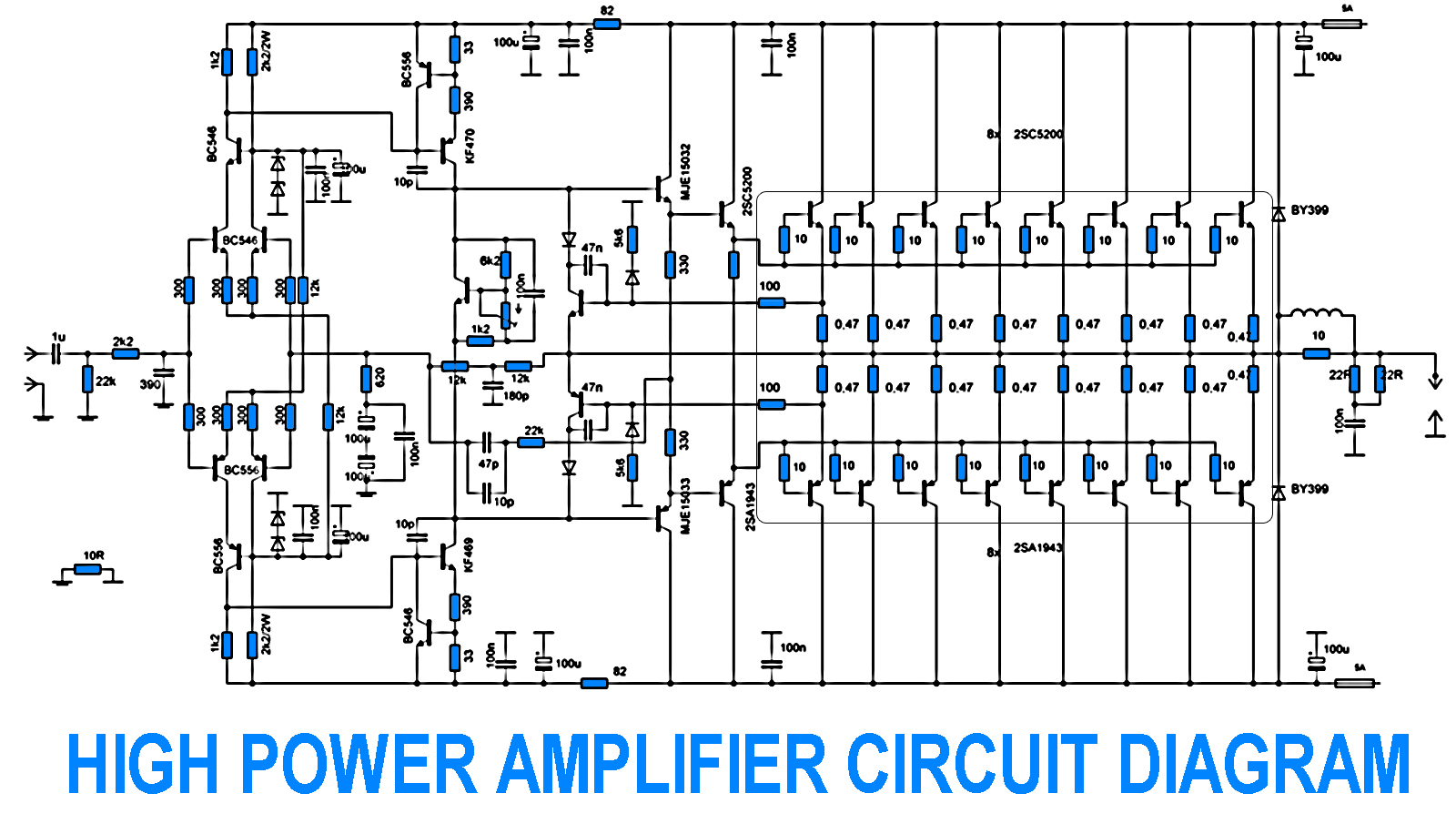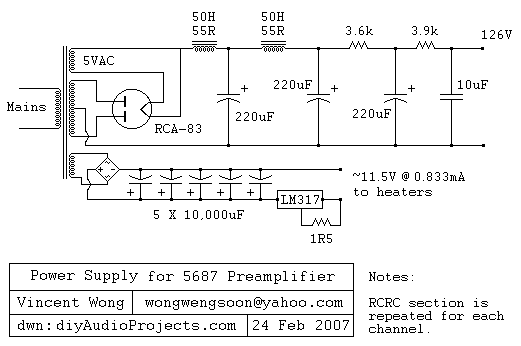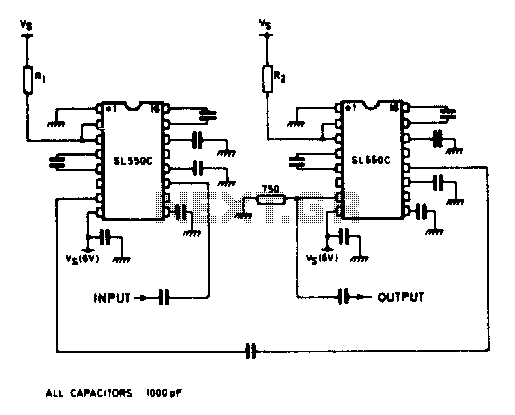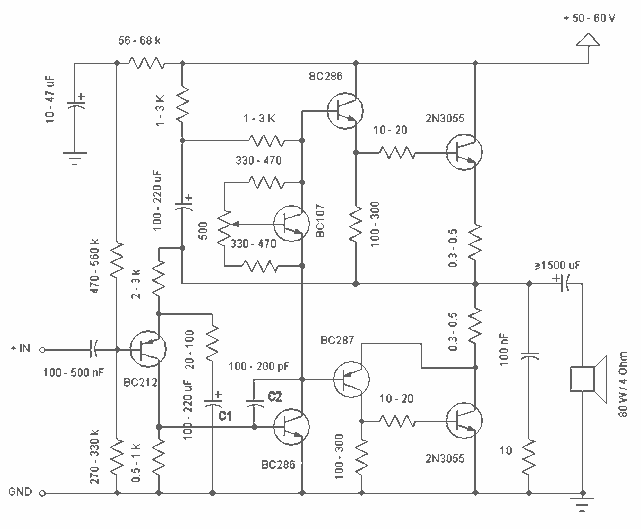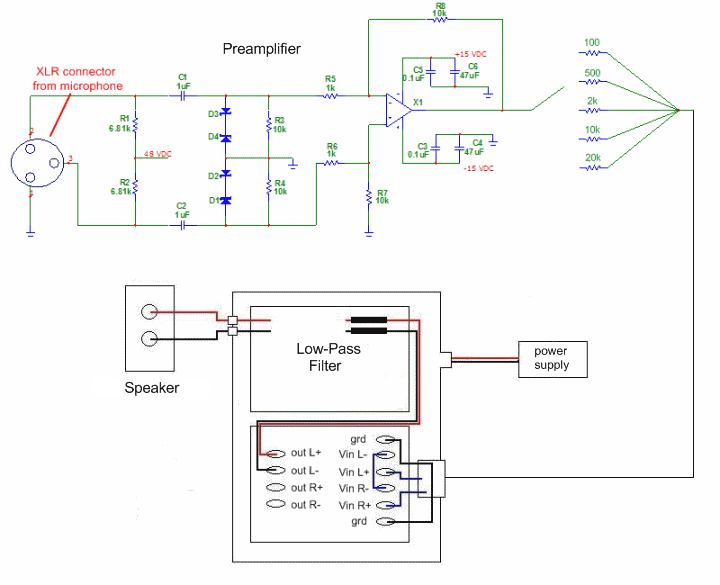
22 watt car subwoofer amplifier
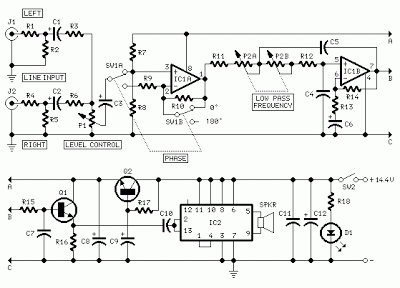
This simple subwoofer circuit is designed to connect to an existing car stereo amplifier, providing the additional "punch" often required for music by driving a subwoofer. Since very low frequencies are omnidirectional, a single amplifier is necessary to drive the dedicated speaker. The power amplifier utilizes a Philips IC BTL TDA1516BQ, which requires a minimal number of components and is capable of delivering approximately 22 W into a 4-ohm load at a standard battery voltage of 14.4 V. The signals from the car stereo's line output amplifier are mixed at the input; after the level control, the signal enters a buffer and can be phase-reversed via SW1. This feature allows the subwoofer to be in phase with the existing car radio speakers. A variable 12 dB/octave low-pass filter is configured around IC1B, Q1, and the listed components, enabling precise adjustment of the low-pass cutoff frequency between 70 Hz and 150 Hz. Q2, R17, and C9 form a simple voltage stabilizer for the input and filter circuits, which helps prevent interaction between the positive rail of the power amplifier and the low-level sections.
This circuit is structured to enhance the audio experience in automotive environments by effectively integrating a subwoofer into the existing sound system. The use of the Philips TDA1516BQ integrated circuit as a power amplifier is significant due to its efficiency and compact design, which minimizes the number of external components required.
The input stage of the circuit is designed to accept the line-level output from the car stereo, which is then processed through a level control to adjust the signal strength before buffering. The buffer stage is essential for maintaining signal integrity and preventing loading effects on the stereo output. The inclusion of a phase reversal switch (SW1) allows for flexibility in speaker phase alignment, which is crucial for achieving optimal sound quality and coherence in the audio reproduction.
The low-pass filter configuration is vital for subwoofer operation, as it ensures that only the desired low-frequency signals are sent to the subwoofer while filtering out higher frequencies that could cause distortion. The adjustable cutoff frequency, ranging from 70 Hz to 150 Hz, provides the user with the ability to tailor the subwoofer's response to match their specific listening preferences and the acoustics of their vehicle.
The voltage stabilization circuit composed of Q2, R17, and C9 is a critical addition, ensuring that the input and filter stages receive a stable voltage supply. This stability is essential for maintaining consistent performance and preventing noise that could arise from fluctuations in the power supply, particularly in the automotive environment where electrical noise is prevalent.
Overall, this subwoofer circuit design represents an effective solution for enhancing the bass response in car audio systems, combining simplicity, efficiency, and adaptability to meet the needs of automotive audio enthusiasts.This Simple subwoofer circuit is designed to be connected to an existing car stereo amplifier, adding that often require extra "punch" to music by driving a subwoofer. As the very low frequencies are omnidirectional, a single amplifier is necessary to promote the dedicated speaker.
The power amplifier using a Philips IC BTL TDA1516BQ requiring a v ery low number of components and capable of delivering about 22 W into a 4 ohm load on the battery voltage of 14. 4 standard car. The signals from the stereo line output amplifier car stereo mix in the entry, after the control level, the signal enters the buffer and can be IC1A reversed phase through SW1.
This control can be useful to allow the subwoofer to be in phase with the speakers in your car radio today. Then a variable 12dB/octave filter low pass frequency around IC1B, Q1 and components listed below, which allows precise adjustment of the low pass rate of 70 to 150Hz.
Q2, R17 and C9 form a simple voltage stabilizer for the input and filter circuits, useful to prevent interaction of the positive rail power amplifier to the low-level sections. 🔗 External reference
This circuit is structured to enhance the audio experience in automotive environments by effectively integrating a subwoofer into the existing sound system. The use of the Philips TDA1516BQ integrated circuit as a power amplifier is significant due to its efficiency and compact design, which minimizes the number of external components required.
The input stage of the circuit is designed to accept the line-level output from the car stereo, which is then processed through a level control to adjust the signal strength before buffering. The buffer stage is essential for maintaining signal integrity and preventing loading effects on the stereo output. The inclusion of a phase reversal switch (SW1) allows for flexibility in speaker phase alignment, which is crucial for achieving optimal sound quality and coherence in the audio reproduction.
The low-pass filter configuration is vital for subwoofer operation, as it ensures that only the desired low-frequency signals are sent to the subwoofer while filtering out higher frequencies that could cause distortion. The adjustable cutoff frequency, ranging from 70 Hz to 150 Hz, provides the user with the ability to tailor the subwoofer's response to match their specific listening preferences and the acoustics of their vehicle.
The voltage stabilization circuit composed of Q2, R17, and C9 is a critical addition, ensuring that the input and filter stages receive a stable voltage supply. This stability is essential for maintaining consistent performance and preventing noise that could arise from fluctuations in the power supply, particularly in the automotive environment where electrical noise is prevalent.
Overall, this subwoofer circuit design represents an effective solution for enhancing the bass response in car audio systems, combining simplicity, efficiency, and adaptability to meet the needs of automotive audio enthusiasts.This Simple subwoofer circuit is designed to be connected to an existing car stereo amplifier, adding that often require extra "punch" to music by driving a subwoofer. As the very low frequencies are omnidirectional, a single amplifier is necessary to promote the dedicated speaker.
The power amplifier using a Philips IC BTL TDA1516BQ requiring a v ery low number of components and capable of delivering about 22 W into a 4 ohm load on the battery voltage of 14. 4 standard car. The signals from the stereo line output amplifier car stereo mix in the entry, after the control level, the signal enters the buffer and can be IC1A reversed phase through SW1.
This control can be useful to allow the subwoofer to be in phase with the speakers in your car radio today. Then a variable 12dB/octave filter low pass frequency around IC1B, Q1 and components listed below, which allows precise adjustment of the low pass rate of 70 to 150Hz.
Q2, R17 and C9 form a simple voltage stabilizer for the input and filter circuits, useful to prevent interaction of the positive rail power amplifier to the low-level sections. 🔗 External reference
